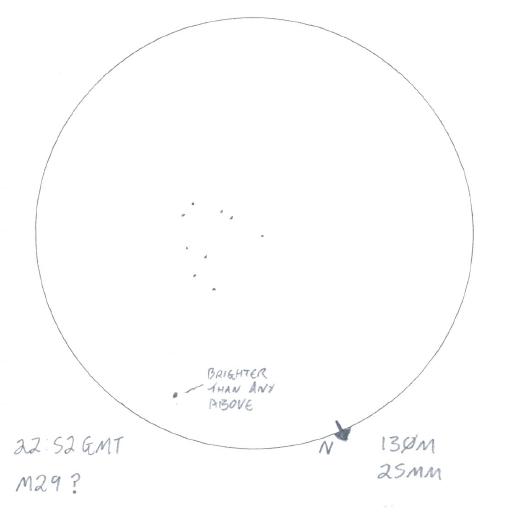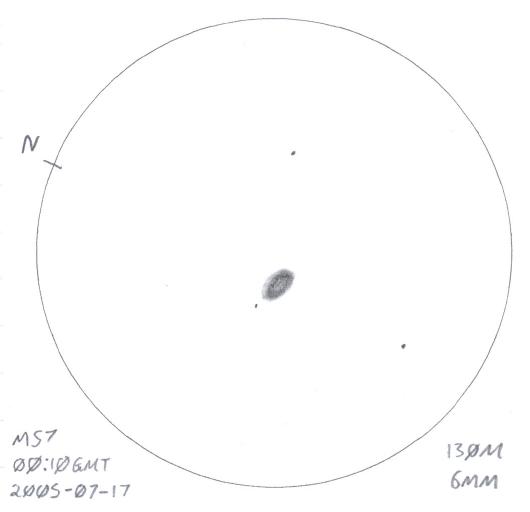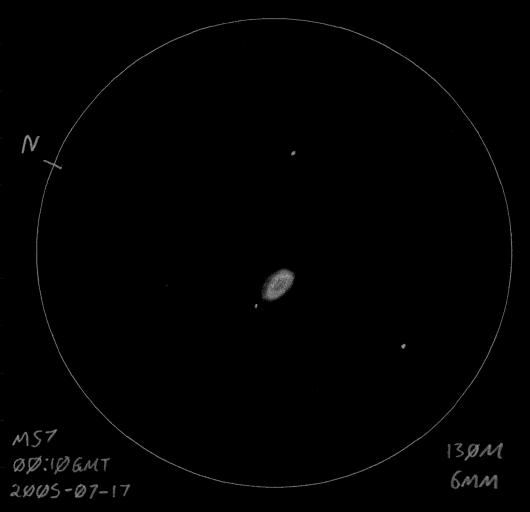2005-07-16
| Location: | Billingborough (South Lincolnshire, UK) |
| From: | 2005-07-16 21:27 UT |
| To: | 2005-07-17 00:15 UT |
| Equipment: | Naked Eye Sky-Watcher Explorer 130M Meade 10x50 Binoculars |
| Notes: |
Another reasonable night's observing. Sky seemed quite clear, I think I'd have rated the transparancy as "pretty good" and seeing seemed "very good". The temperature was cool but pleasant. Waxing gibbous Moon. |
Moon
| From: | 2005-07-16 21:27 UT |
| To: | 2005-07-16 21:40 UT |
|
With the naked eye I noticed that on the terminator of the Moon there was an obvious and significant feature jutting into the night-side. For some reason I don't think I've ever really noticed something as obvious as this before. Using the 130M and a 25mm eyepiece I could see that it was part of Montes Jura, which partly surrounds Sinus Iridum. I was contemplating trying to make a sketch of the scene when I started to lose the Moon behind a neighbour's house. |
Albireo
| From: | 2005-07-16 22:00 UT |
| To: | 2005-07-16 22:24 UT |
|
Turned the 130M on Albireo (β Cygnus) and companion. Started with the 25mm eyepiece. Reasonably wide pair. Noticed that there seems to be a faint difference in colour but I couldn't quite tell for sure exactly what it was. One of the pair seemed to be slightly more blue in appearance (the fainter of the pair) whereas the other seemed much more white. Switched to the 15mm eyepiece. Now the brighter of the pair appeared to have a faint orange tint to it. The fainter of the pair had a slight blue tint. With the 10mm eyepiece the effect was the same as with the 15mm but the colours were more pronounced. With the 6mm eyepiece the colours were even more pronounced. My impression was that the brighter of the pair has an orange/white appearance to it and the fainter of the pair has a blue/white appearance. |
Attempt to find M29
| From: | 2005-07-16 22:31 UT |
| To: | 2005-07-16 22:52 UT |
|
Decided to have a go at finding M29 in Cygnus. Pointed the 'scope in the general location of the cluster. Using the 25mm eyepiece I thought I'd found it after discounting a couple of candidates. I found this very hard-going given that this is a very star-rich part of the sky due to it lying in the "thicker" part of the Milky Way. Finding it hard to tell if I'd got the right object or not I grabbed my copy of Neil Bone's Deep Sky Observer's Guide to see if that could help me check if I'd got the right object. Sadly there was no illustration for this object but the text described it as a "south-pointing triangle". The collection of stars that I'd finally settled on seemed to fit the bill but I was still unsure that I'd really found M29. Made a sketch of what I'd found so I could check later against any images I could find: Checking afterwards with Starry Sky I found that what I'd sketched wasn't M29. Annoyingly, I had actually seen M29 but had discounted it as what I saw didn't seem to match the description I'd read. What I had drawn (ignoring the brighter star that I'd marked) was, from what I can tell, the following stars: TYC3152-1679-1, TYC3151-955-1, TYC3151-757-1, TYC3151-1782-1, TYC3151-1591-1, TYC3151-478-1, TYC3151-1573-1, TYC3151-1237-1 and TYC3151-550-1. The bright star I marked was 34 Cygni. Seems I was about 1° off. It strikes me that there are two useful lessons here: the first is that I should do a little more preparation before going hunting for an object such as this (one that could be easily confused in a star-rich area); the second lesson is that when you're unsure about something you think you've found doing a sketch for later comparison is a good thing. |
M31
| From: | 2005-07-16 23:10 UT |
| To: | 2005-07-16 23:20 UT |
|
Noticed that M31 had risen enough to clear the murk of the eastern horizon (not to mention the roofs of the houses near me). Couldn't quite see it with the naked eye (then again there is a street light in that direction and it was still reasonably low down) but found it very easily with 10x50 binoculars. Could see the central bulge rather well with a faint hint of the rest of the galaxy. I would have turned the 130M on it but, annoyingly, it was obscured by my Pear Tree from where I was set up and I didn't want to get into moving the 'scope and realigning it and everything at that point. I'll save M31 and the 130M for another night when it's higher in the sky. |
M51
| From: | 2005-07-16 23:25 UT |
| To: | 2005-07-16 23:50 UT |
|
Decided to have a go at M51. It wasn't very favourably placed given that it was off in the Western part of the sky and given that that part of the sky wasn't anywhere near fully dark. Using the 25mm eyepiece, after a little bit of effort, I found it. Although all I could see was two faint fuzzy blobs it seemed pretty obvious that it was M51. There was no hint that I was actually looking at a spiral galaxy. With averted vision the blobs did seem a little more extended. Dropped the 15mm eyepiece into the 'scope and had another look. The impression I got was that it looked a little brighter and, with averted vision, there was the vague impression that the "extensions" to the blobs mentioned above appeared to overlap. The really enjoyable part about seeing M51 was the realisation that I was looking back in time somewhere in the region of 30 million years or more. |
M57
| From: | 2005-07-16 23:55 UT |
| To: | 2005-07-17 00:15 UT |
|
Decided to have another look at at M57. Given that Lyra was better positioned than the last time I observed it I wanted to see what would be visible with the 6mm eyepiece (I'd tried using it during the last observing session but couldn't see much at all). Also, the sky seemed a lot darker and clearer that the last time (for example, I could now easily see the Milky Way with the naked eye, something I couldn't do the other night). First located M57 with the 25mm eyepiece, centered it in the field of view and then immediately switched to the 6mm. Noticed right away that the "hole" was very visible, I could more or less detect it with direct vision. Also noticed something that I'd not noticed in the previous observing session: a faint star just to the side of the nebula. I also thought I could detect a faint variation in brightness in the ring but it was hard to pin down exactly where this was and what form it took (this was only really noticeable with averted vision). Made a sketch: As an experiment I've taken the above, converted it into a gray-scale image and then inverted the colours. This is the result:
At 00:15 UT I finished the session. |


